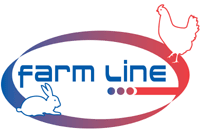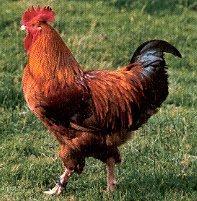

| Sponsors partenaires du MCF, informations et conditions par mail : CONTACT | |||||||
 |
|
 |
|||||
Photos sous licence Creative Commons
type http://creativecommons.org/licenses/by-sa/3.0/deed.fr
CC by sa
|
The black tailed Buff variety |
 |
|
|
The Black tailed Buff variety
as well as the "wheat" variety are two
colors which have narrow links, allowed among other
things by the membership of the same genetic family.
In order to be clear and precise, we should speak of Black tailed Buff Marans and not simply of fawn or buff Marans. Indeed, this last term, when it is used by itself, corresponds to a well-precised genetic term like the "orpington" for example, i.e a very uniform and without any black marks light fawn color, which to be right, is called "plain fawn". This plain-fawn color, which is genetically complex (and it is virtually impossible to cross it with another color), doesn't exist in the Marans which isn't apparently composed of the whole and numerous gentic factors responsible for this color. |
Indeed, it is advisable to remind you of the descending order of dominance of the most important Marans variety :
Cuckoo > Brown-red > Wheat > Buff
Consequently, it is in this way easier to understand that from a little hen pen of Brown-red breed stock for example (when there is a certain genetic impurety within of course) can appear "wheat" or fawn-colored subjects, certainly more or less good but however which are often useful.
The opposite is mathematically possible. As the Brown-red characteristic is dominating, apparently it would appear visually in the plumage. If it must be present in the genetic characteristics of a considered buff or wheat subject.
Moreover, "wheat" breeding stock can give birth to Black tailed Buff subjects which show without the slighest doubt taht such ancestral "wheat" subjects are impure because thet convey in the latent state some recessive genes responsible for this Black tailed buff color.
Furthermore, we can say very simply and theorically that a true hen pen of Black tailed Buff breeding stock (obtained afteer a selection which was correctly supported for this color) can't be get "wheat" subjects anymore and even less young Brown-red or even cuckoo or plain-black subjects.
The risks to see appearing the famous and classic colors of the Marans from real subjects become nul. Only the genetic factor responsible for the white feathers can possibly appear (in any genetic family) because it acts in a very different way. You can see this subject in "white Marans".
The golden-salmon variety (Black-red Marans) could also theorically come into the world. It really exists but today it is still extremly rare. What a pity !
Concerning the selection mistakes which were made, during decades, the real pure "wheat-colored" cocks which seem to be like the Brown-red have often been wrongly and by ignorance rejected of the selection which concerns them, i.e the real genetic "wheat" variety. These "wheat" cocks, which are usually mistaken with the Brown-red variety came from time to time to illegitimate the Brown-red founders. It is obvious. The constat was made. Today, these coppery-black stocks still give birth to young "wheat" or ...Black tailed Buff subjects.
In the same time, as for the Black tailed Buff cocks (which were wrongly called "red") were wrongly associated with real "wheat" hens which seem pretty fawn. The color of these hens was genetically dominating. It constantly reappears. So it is the vicious circle of an illegitimate and erroneous selection but which is however locked within only one genetic family from which it never comes out !
This illegitimate selection between Black tailed Buff and "wheat" can never end up in a steady result for a color variety that noone has ever been able to call as it should be.
Consequently, this phenomenon explains the former and absurd name "red-(or yellow)-salmoned-fawn-partridge" for a Marans variety which in reality is only constituted by eternally odd breeding stocks : buff (or fawn) cocks, more or less "wheat" hens, explaining the erroneous terms "salmoned-fawn and "partridge", either by the slight drawing of the hen feathers or perhaps by the brown miror on the "wheat" cock wing.
Therefore, it would be proper to select and to isolate the Wheat breeders as well as the Black tailed Buff ones. In a way<, it means to do what has never been correctly applied at the beginning.
The fawn Marans selection
Concerning the cocks
It is very easy to
recognize from the young age the real fawn-colored cock whose red-fawn
color is quite strong on the whole body.
Only the ends (remexs and caudals) are more or less black. On the
contrary of the "wheat" whose breast and undersides are
black.
In the two cases, the hackles are coppery and similar. They can't
be differentiated.
We have seen tant
the "Wheat" hens are not uniform as for the color on
the whole body.
Their red-fawn hackle and their light breast clearly contrast.
The shades on the back and on the wings remind us the shade of
the grains of wheat, i.e a whole and not very strong color
contrary to the fawn hen's.
Indeed, the fawn hens, when they are correctly selected, must
have aquite strong and uniform color which is a very rare
occurrence.
The ideal plumage
of the fawn with a black tail Marans must be close to the new
Hampshire breed hen color which can be a model.
The crossing mistakes, which have been frequent for a long time
can explain the currently met difficulties to find fawn
hens correctly supported as for color and conformity (as the
selection work has never been done in a sufficient way).
The current fawn-colored Marans cocks are relatively common and their colors correspond to those of the New Hampshire breed.
Such cocks are often exhibited during the different championships. On the contrary, the hens are not always very uniform and seem impure. Sometimes, they almost seem to be as "wheat" than fawn-colored. Anyway, they constitute a very good base of work for the fawn variety from the moment we make up our mind to cross them with cocks which are naturally dedicated to them.
The fawn hens having a too light plastron must be rejected. The uniformity of strong fawn-colored feathers must be looked for whereas that for the fawn-colored cock choice, the work seems to be easily and even already naturally realised.
Photos sous licence Creative Commons
type http://creativecommons.org/licenses/by-sa/3.0/deed.fr
CC by sa
|
The fawn-colored Marans is :
|
|
To avoid the confusions with the red color:
If the fawn with a black tail variety is not a "wheat" subject, it is not either a "red".
Once again, it is advisable to say that colud only be considered as "red" Marans the subjects which show as well as for the cock as for the hen, a uniform, very strong reddish-brown plumage. (including the hackle and lancets). It's the case of the red Rhode Island breed.
Otherwise, the genetic impurety characteristic is almost obvious.
So the correct fawn colored with black tail cocks, even though they have strong colors, are not entirely uniform but on the contrary shady.
So we mention three shades in the New Hampshire breed for example. Indeed, the hackles and the lancets, notably of the cocks, show a coppery-gold shade and have colored tips. They are not uniform auburn-red as the true genetic "red" color of the Rhode Island variety defines it.
For lack of a serious selection made so far, as well as by the clumsy selections with the "wheat" color, the present fawn-colored subjects seen the show very varied feathers in the hens (from an uniform light fawn color with a black tail to a more or less uniform strong fawn color.). The color seems to be much well-stabilized in the cocks because as for the hens, the feathers seem varying from the "wheat" color to the true fawn color.
Description of the fawn-colored with black tail hen
THE OFFICIAL VARIETIES OF THE CURRENT STANDARD
|
Silver-cuckoo Variety |
|
OTHER VARIETIES NOT APPROVED YET